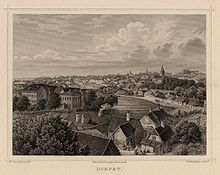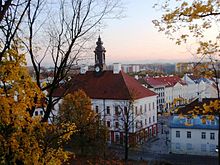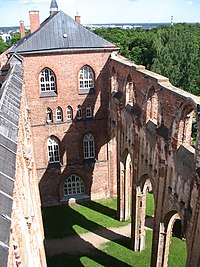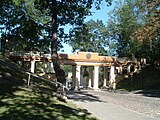Tartu
| Tartu | |||
|
|||
| State : |
|
||
| Circle : |
|
||
| Founded : | before 1262 | ||
| Coordinates : | 58 ° 22 ' N , 26 ° 43' E | ||
| Height : | 79 m | ||
| Area : | 38.8 km² | ||
| Residents : | 98,480 (2013) | ||
| Population density : | 2,538 inhabitants per km² | ||
| Time zone : | EET (UTC + 2) | ||
| Postal code : | 50050-51111 | ||
| License plate : | T | ||
| Community type: | city | ||
| Mayor : | Urmas Klaas | ||
| Website : | |||

|
|||
Tartu ( German and Swedish : Dorpat , formerly German also Dörpt; Russian Дерпт Derpt , 11th – 17th centuries, 1893–1918 Юрьев / Jurjew ) is Estonia's second largest city after the capital Tallinn and the seat of the University of Tartu . The former Hanseatic City of Livonia is located in the Tartu district . In 2024 Tartu will be one of the three European Capitals of Culture , alongside Bad Ischl in Austria and the Norwegian city of Bodø .
Geography and climate
The city of Tartu lies on both sides of the river Emajõgi ("mother river", German Embach ). To the north of the city lies the rural community of the same name, Tartu .
| Tartu | ||||||||||||||||||||||||||||||||||||||||||||||||
|---|---|---|---|---|---|---|---|---|---|---|---|---|---|---|---|---|---|---|---|---|---|---|---|---|---|---|---|---|---|---|---|---|---|---|---|---|---|---|---|---|---|---|---|---|---|---|---|---|
| Climate diagram | ||||||||||||||||||||||||||||||||||||||||||||||||
| ||||||||||||||||||||||||||||||||||||||||||||||||
|
Average monthly temperatures and rainfall for Tartu
Source: wetterkontor.de
|
|||||||||||||||||||||||||||||||||||||||||||||||||||||||||||||||||||||||||||||||||||||||||||||||||||||||||||||||||||||||||||||||||||||||||||||||||||||||||||||||||||||
history
The first written mention under the name Tharbatas dates from the year 1030. The Grand Duke of Kiev, Yaroslav the Wise , destroyed a wooden fortress built by presumably Finno-Ugric inhabitants in 1030 and built it under the name Yuryev (after Yuri, the baptismal name of Yaroslav) a fortress. In 1224 the Estenburg Tharbatum was conquered by the Order of the Sword Brothers . It became the seat of the bishop (until 1558); in front of the castle, the Hanseatic city developed since the 13th century . In the Middle Ages , Dorpat was a link between the Hanseatic cities (especially Reval ) and the Russian cities of Pleskau (Pskow) and Novgorod . Dorpat belonged to the Russian Empire ( Livonia Gouvernement ) since 1721 .
A large fire destroyed almost the entire city center in 1775. The most striking older buildings date from the 18th and especially the 19th century. After the previous town hall building also fell victim to the fire, the current town hall was designed in the 18th century by the city architect at the time , Johann Heinrich Bartholomäus Walther from Rostock , and completed in 1789.
In 1893 the city was officially renamed Yuryev in the course of Russification ; the use of the Estonian or the German name was partially prohibited. The Russian name didn't catch on, not even in Russian . When Estonia gained independence in 1918, the name "Tartu" became official. Both Dorpat and Tartu come from the Old Estonian name Tarbata , with the possible meaning " aurochs ".
On February 2, 1920, the Peace of Dorpat between Estonia and Soviet Russia was signed in Tartu , in which the latter recognized Estonia's independence "for all time".
In the city there was the Soviet POW camp 331 for German POWs of the Second World War .
On June 23, 2016, Tartu was awarded the honorary title of “ Reformation City of Europe ” as the 62nd city by the Community of Evangelical Churches in Europe .
education
University of Tartu

Tartu is a typical student town, dominated by the Dorpat University, founded in 1632 by King Gustav II Adolf , which was re-founded in 1802 by the Baltic Germans with the help of Tsar Alexander I as the only German-speaking university in the Russian Empire. The first rector of the university was Georg Friedrich Parrot , who came from Livonia and is remembered by the inscription on the “ingli sild” / “Angel's Bridge” on Domberg. The university became a mediator between Russian and German culture and was the hub of east-west relations, but at the same time also became the birthplace of the Estonian and Latvian national awakening. The Estonian national colors were originally those of the student union “ Association of Estonians Students ” at the university. During the years 1886 to 1889 an uncompromising Russification took place, in the course of which German was replaced by Russian as the teaching language, which is why the majority of the formerly over 90% German teachers moved to Germany. After 1919, the university became the national university (Estonian Eesti Vabariigi Tartu Ülikool ) of the now independent Republic of Estonia and remained the most important university in Estonia during the subsequent Soviet period (1940-1991). Today the University of Tartu is the only comprehensive university in Estonia and the mother university for Tallinn University of Technology and the University of Life Sciences.
In 2004, 18,000 students faced 135 professors and 700 other teachers. Around 440 people work in research. You can come up with 4000 scientific publications annually. There are many student associations active at the university , which, compared to Germany, have a lively influx of new members. Tartu is also home to a modern medical research facility , the Biomeedikum .
Colleges and schools
Tartu is one of six locations of the private Estonian Entrepreneurship University of Applied Sciences ( EEUAS ), an art school as well as the Tartu Raatuse Gümnaasium, a school with numerous connections to the German-speaking area, and the Tartu Waldorfgümnaasium .
There are also two armed forces teaching facilities in Tartu: the Estonian National Defense Academy and the Baltic Defense College, which is operated jointly with the other two Baltic states .
population
Population development
| 1825 | 1833 | 1840 | 1847 | 1856 | 1863 | 1867 | 1881 | 1897 |
|---|---|---|---|---|---|---|---|---|
| 8450 | 10,020 | 12.203 | 12,185 | 12,914 | 14,386 | 21,014 | 29,974 | 42,308 |
| 1922 | 1934 | 1939 | 1959 | 1970 | 1979 | 1989 | 2000 | 2010 |
| 50,342 | 58,876 | 60.281 | 74,263 | 90,459 | 104,518 | 113,977 | 98,695 | 103.284 |
Historical population distribution
| population | 1867 | 1881 | 1897 | 1922 | 1934 | |||||
|---|---|---|---|---|---|---|---|---|---|---|
| number | % | number | % | number | % | number | % | number | % | |
| Estonians | 9,720 | 46.3 | 16,526 | 55.4 | 29,039 | 68.6 | 42,459 | 84.5 | 51,559 | 87.6 |
| German | 8,907 | 42.4 | 10,486 | 35.2 | 7,020 | 16.6 | 3.210 | 6.4 | 2,706 | 4.6 |
| Russians | 1,866 | 8.9 | 1,818 | 6.1 | 3,689 | 8.7 | 2,570 | 5.1 | 2,640 | 4.5 |
| Other | 521 | 2.5 | 1,144 | 3.8 | 2,560 | 6.1 | 2,103 | 4.2 | 1,971 | 3.3 |
| total | 21,014 | 100 | 29,974 | 100 | 42,308 | 100 | 50,342 | 100 | 58,876 | 100 |
Culture and sights
The entire old town of Tartus with the town hall , the town hall square, the shopping streets and the classical university main building is worth seeing . Numerous other university buildings are scattered across the city. The medieval Johanniskirche , a Gothic brick building with art-historically significant terracotta figures , whose reconstruction was completed in 2005 after being destroyed in the Second World War, is visible from afar .
On the Toom Hill, Estonian "Toomemägi", there are the ruins of the medieval cathedral (whose expanded choir first served as the university library and now houses the university museum) as well as other university buildings, such as the observatory ( 58 ° 22 ′ 44 ″ N , 26 ° 43 ′ 12 ″ O , part of the Struve-Bogen World Heritage Site ) and the old anatomical theater, where anatomical lectures were held until the mid-1990s .
Tartu has several theaters, stages and art projects, as well as various exhibitions on the history of the city and the university. In addition to the University's Botanical Garden, there are several parks and green spaces in the old town (e.g. Toompea, Barclay Park) and along the river Embach, which crosses the city.
Tartu is the seat of the Estonian National Museum and the Estonian Museum of Literature .
In 2019 Tartu was selected as European Capital of Culture 2024.
Exterior view of the Johanniskirche
Tartu Cathedral (partial ruin)
The town hall, built from 1782–1789, is the work of the Rostock- born architect Johann Heinrich Bartholomäus Walter (1734–1802)
Town twinning
Sister cities of Tartu are:
-
 Lueneburg , Germany
Lueneburg , Germany -
 Veszprém , Hungary
Veszprém , Hungary -
 Tampere , Finland
Tampere , Finland -
 Uppsala , Sweden
Uppsala , Sweden -
 Pskov , Russia
Pskov , Russia -
 Ferrara , Italy
Ferrara , Italy -
 Salisbury , United States
Salisbury , United States -
 Turku , Finland
Turku , Finland -
 Bærum , Norway
Bærum , Norway -
 Frederiksberg , Denmark
Frederiksberg , Denmark -
 Hämeenlinna , Finland
Hämeenlinna , Finland -
 Hafnarfjordur , Iceland
Hafnarfjordur , Iceland -
 Kaunas , Lithuania
Kaunas , Lithuania -
 Deventer , Netherlands
Deventer , Netherlands -
 Riga , Latvia
Riga , Latvia -
 Zutphen , the Netherlands
Zutphen , the Netherlands
There is also a “city friendship” with Greifswald , Germany (since 2006).
![]()
There is a friendly or partnership relationship with other cities:
Sports
In Tartu under the will worldloppet the ski marathon Tartu Maraton 63 kilometers from Otepää to Elva aligned. In 2017 the world championship in orienteering took place in Tartu. Well-known ice hockey clubs in the city are Tartu Kalev-Välk and the Tartu Big Diamonds . The most famous football club is the JK Tammeka Tartu . The Tartu Rock basketball team takes part in the Estonian Meistriliiga as well as in the Baltic Basketball League and the EuroChallenge . The team currently plays in the first soccer league, Meistriliiga . The rugby team Tartu Lelo plays in the Estonian first rugby league.
Others
In the 1930s the Baltic Family History Announcements were published in Dorpat . In July 2005 the 25th International Hanseatic Days ( Hanseatic Days of Modern Times ) took place in Tartu .
Personalities
sons and daughters of the town
To 1900
- Heinrich von Stackelberg (around 1305), shop steward and vassal of the Bishop of Dorpat
- Lorenz Möller , also Latinized Laurentius Molitor († presumably 1571 in Reval), Evangelical Lutheran theologian and educator
- Jakob von Eggers (1704–1773), general, commandant of Danzig
- Karl Ernst von Baer (1792–1876), zoologist and biologist, discoverer of the egg cell
- Karl Ernst Claus (1796–1864), German-Russian pharmacist and the chemist who discovered ruthenium
- Konrad Siegmund von Brasch (1779–1835), Livonian landlord
- Karl Friedrich Knorre (1801–1883), astronomer and mathematician
- Emil Lenz (1804–1865), physicist
- Alexander Wrangel (1804-1880), Russian infantry general
- Lionel Kieseritzky (1806-1853), Livonian chess master
- Ernst Adolph Herrmann (1812–1884), historian and university professor
- Hermann Martin Asmuss (1812–1859), zoologist (entomologist) and paleontologist
- Hermann Eduard Hartmann (1817–1881), Baltic German painter and graphic artist
- Konrad August von Brasch (1820–1884), Baltic state politician
- Julie Wilhelmine Hagen-Schwarz (* 1824 at Gut Klein-Wrangelshof (Väike-Prangli) near Tartu, † 1902 ibid), painter
- Wilhelm Blum (1831–1904), German lawyer and member of the Reichstag
- Edmund Carl Julius Krüger (1836–1909), German-Baltic pedagogue and archaeologist
- Konrad Freifeldt (1847–1923), clergyman, vice-president of the Evangelical Lutheran General Consistory in the Russian Empire
- Hermann von Bruiningk (1849–1927), Baltic historian
- Alexander Wilhelm Prale (1850-1910), architect of the in Flensburg looked, there Burg Schöneck built
- Julius von Klever (1850–1924), Russian painter
- Adolf von Harnack (1851–1930), theologian
- Oskar Hoffmann (1851–1912), Russian-German-Baltic painter from the Düsseldorf School
- Alphons Thun (1853–1885), economist
- Wolfgang von Oettingen (1859–1943), art and literary historian
- Moritz Wilhelm Paul Schwartz (1864–1919), German-Baltic pastor and Protestant martyr
- Walter von Engelhardt (1864–1940), garden architect, director of the Düsseldorf Horticultural Office
- Bernhard Böttcher (1870–1904), dermatologist and book author
- Herman Anders Krüger (1871–1945), German literary scholar, writer and politician
- Erhard Schmidt (1876–1959), German mathematician
- Georg Hackenschmidt (1878–1968), wrestler and weightlifter
- Otto Hermann (1878–1933), composer and conductor
- Herbert von Oettingen (1878–1946), superintendent and headmaster
- Otto Loening (1880–?), German lawyer and politician, Vice President of the Danzig People's Day
- Gustav Braun (1881–1940), German geographer and university professor
- Hermann Loeschcke (1882–1958), German pathologist and university professor
- Leonid Alexejewitsch Kulik (1883–1942), Russian mineralogist
- Kurt Heinrich Meyer (1883–1952), chemist and since 1932 Professor of Chemistry in Geneva
- Paul Hoffmann (1884–1962), physiologist
- Cezaria Anna Baudouin de Courtenay-Ehrenkreutz-Jędrzejewiczowa (1885–1967), Polish ethnologist, art historian and linguist
- Erich von Mendelssohn (1887–1913), writer, poet and translator
- Hans Thoma (1887–1973), German engineer
- Erich Seeberg (1888–1945), German Protestant theologian and church historian
- Ania Teillard , b. Mendelssohn (1889–1978), graphologist and writer
- Hellmuth Krüger (1890–1955), author, actor and cabaret artist
- Herbert Boehm (1894–1954), German architect, town planner and construction officer
- Else Hueck-Dehio (1897–1976), writer
- Dimitrij Andrusov (1897–1976), Slovak geologist and explorer of the Western Carpathians , grandson of Heinrich Schliemann
- Carl Erdmann (1898–1945), German historian and medievalist
- Felix Kersten (1898–1960), Finnish physiotherapist
- Hellmuth Kneser (1898–1973), German mathematician
- Gerhard Graubner (1899–1970), German architect
1901 to 1950
- Ernst Krenkel (1903–1971), Soviet polar explorer; Radio operator of the sunken ship Cheliuskin and the Soviet North Pole Expedition North Pole-1
- Linda Saul (1907–1997), conductor
- Edgar Hark (1908–1986), Evangelical Lutheran pastor and archbishop
- Wilhelm Hahn (1909–1996), German Protestant theologian and politician (CDU)
- Walter Kremser (1909–2000), German forest scientist
- Wolf von Engelhardt (1910–2008), geologist and mineralogist
- Erik Thomson (1915–1990), Baltic German farmer and writer
- Erik Verg (1919–2005), German journalist
- Villem Gross (1922–2001), writer and journalist
- Ilmar Kullam (1922–2011), basketball player
- Hans-Dieter Brunowsky (1923–2012), naval officer, economist and writer
- Paul Kaegbein (* 1925), German librarian in Berlin and Cologne
- Peter Boerner (1926–2015), German-American literary scholar and Goethe researcher
- Ain Kaalep (* 1926), writer and literary scholar
- Karin Saarsen (1926–2018), writer and journalist
- Hans Luik (1927–2017), writer and translator
- Eno Raud (1928–1996), writer and children's book author
- Reginald Gruehn (1929–2002), German chemist, Prof. f. Inorganic u. Analytical chemistry at the University of Giessen
- Bengt von zur Mühlen (1932–2016), German film producer
- Hanno Selg (1932–2019), modern pentathlete and university professor
- Gero von Wilpert (1933–2009), author and literary scholar
- Mart-Olav Niklus (* 1934), biologist and former Riigikogu member of parliament
- Aarand Ross (1940–2020), writer, Finnougrist and diplomat
- Toomas Savi (* 1942), politician
- Jaak Panksepp (1943–2017), Estonian-American psychologist and university professor
- Anatoli Krikun (* 1948), Soviet basketball player and coach
- Endel Nõgene (* 1950), conductor
From 1951
- Miia Rannikmäe (* 1951), chemist, chemistry teacher and university professor
- Viljar Loor (1953-2011), volleyball player
- Jaak Aaviksoo (* 1954), scientist and politician
- Jaan Ross (* 1957), musicologist and psychologist
- Mati Karmin (* 1959), sculptor
- Sven Jürgenson (* 1962), diplomat
- Sixten Sild (* 1964), orienteer
- Jüri Jaanson (* 1965), rower
- Allan Vainola (* 1965), musician
- Ain Matvere (1967-2018), badminton player
- Kersti Kaljulaid (* 1969), politician, president
- Jaan Kirsipuu (* 1969), cyclist
- Andrus Aug (* 1972), cyclist
- Meelis Lindmaa (* 1970), football player
- Maarika Võsu (* 1972), sword fencer
- Markko Märtin (* 1975), racing car driver
- Kristina Šmigun-Vähi (* 1977), cross-country skier
- Tanel Tein (* 1978), basketball player
- Katrin Šmigun (* 1979), cross-country skier
- Jaanus Uudmäe (* 1980), athlete
- Rolf Roosalu (* 1982), singer and musical actor
- Martin Vunk (* 1984), soccer player
- Oliver Konsa (* 1985), soccer player
- Karl Jaani (* 1985), beach volleyball player
- Alo Jakin (* 1986), racing cyclist
- Mario Hansi (* 1987), soccer player
- Markus Jürgenson (* 1987), soccer player
- Maris Mägi (* 1987), track and field athlete
- Illimar Pärn (* 1988), ski jumper
- Eino Puri (* 1988), soccer player
- Karel Tammjärv (* 1989), cross-country skier
- Mari Klaup-McColl (* 1990), heptathlete
- Siim Tenno (* 1990), soccer player
- Mait Toom (* 1990), soccer player
- Kaur Kivistik (* 1991), track and field athlete
- Eron Krillo (* 1991), soccer player
- Julia Beljajeva (* 1992), sword fencer
- Rasmus Mägi (* 1992), hurdler
- Kaarel Torop (* 1992), soccer player
- Kevin Ingermann (* 1993), soccer player
- Johannes Erm (* 1998), decathlete
Personalities associated with Tartu
Numerous personalities are in contact with Tartu as professors , alumni , students and employees of the university. Also to be mentioned are:
- Friedrich Amelung (1842–1909), Baltic chess player and chess composer
- Andreas Ascharin (1843–1896), Baltic-Russian literary translator and chess player
- Nikolai Bezhanitsky (1859–1919), Russian Orthodox priest of the local St. George's Congregation, martyr at the time of the Estonian War of Independence
- Michael Bleive (1873-1919), Russian Orthodox priest of the local Dormition Church, martyr at the time of the Estonian War of Independence
- Werner Gruehn (1887–1961) was a Protestant theologian and religious psychologist, founder and rector of the private German Lutheran Theological and Philosophical Academy in Dorpat
- Miina Härma (1864–1941), first Estonian composer, organist and well-known choir director, 1939 honorary doctorate from the University of Tartu and appointment as honorary professor at the Tallinn Conservatory
- Traugott Hahn (1875–1919), German Protestant theologian and pastor, professor in Dorpat, martyr of the Estonian liberation struggle and the Protestant Church
- Arnold Hasselblatt (1852–1927), historian and journalist
- Melchior Hofmann (around 1500-1543), Lutheran messenger and later Baptist in Tartu, triggered as a minister 1524 his sermon the Dorpater Bildersturm from
- August Alexander Kämmerer (1789–1858), German geologist and pharmacist, bequeathed a mineral collection to the University of Dorpat
- Friedrich Maximilian Klinger (1752–1831), German poet of Sturm und Drang , died in Dorpat
- Jakob Michael Reinhold Lenz (1751-1792), German poet of the Sturm und Drang , and his family moved to Dorpat in 1759, left the city in 1768 in order to Königsberg to study
- Jaan Tõnisson (1868 – probably July 1941), Estonian publisher, politician, prime minister and head of state of the Republic of Estonia
- Edgar Valter (1929–2006), one of the most important contemporary children's book authors, illustrators and caricaturists in Estonia, died in Tartu
- Johann Anton Weinmann (1782–1858), botanist, first horticultural director of the botanical garden founded in 1803
literature
- Georg von Rauch : City and diocese of Dorpat at the end of the religious era. In: Journal for East Research . Vol. 24 (1975), pp. 577-626.
Web links
- Official site of the city, accessed May 31, 2019 (Estonian, Russian, here: English)
- Tartu - The sophisticated spiritual center of Estonia. In: estlandia.de, August 28, 2019 (with pictures from Tartu)
Individual evidence
- ^ Tartu ( Memento of August 18, 2016 in the Internet Archive ). In: frendy.de, accessed on June 30, 2016.
- ↑ The emphasis on the terms Dorpat and Tartu is on the first syllable.
- ↑ Bodø: Norway's European Capital Of Culture For 2024. In: Forbes . September 25, 2019, accessed October 1, 2019 .
- ↑ Erich Maschke (Hrsg.): On the history of the German prisoners of war of the Second World War. Verlag Ernst and Werner Gieseking, Bielefeld 1962–1977, DNB 540491969 .
- ↑ For the significance of Tartus in the history of the Reformation see the city portrait of the Reformation city of Tartu. Temporary turmoil in the far north of Europe of the project Reformation Cities of Europe. In: reformation-cities.org, accessed on June 29, 2016.
- ^ Campus. In: eek.ee, accessed on May 31, 2019 (Estonian, Russian, here: English).
- ↑ The Art School at a Glance ( Memento from May 24, 2013 in the Internet Archive ) accessed on June 29, 2016.
- ↑ Welcome to us! In: raatuse.rtk.tartu.ee, accessed on June 30, 2016.
- ↑ waldorfkool.info, accessed on June 30, 2016.
- ↑ Статистическое изображение городов и посадов Российской империи по 1825 год. Сост. из офиц. сведений по руководством директора Департамента полиции исполнительной Штера. Спб., 1829.
- ↑ Обозрение состояния городов российской империи в 1833 году / Изд. при министерстве внутренних дел. - Спб., 1834.
- ↑ Статистические таблицы о состоянии городов Российской империи. Сост. в Стат. отд. Совета МВД. - Спб., 1840.
- ↑ Статистические таблицы о состоянии городов Российской империи [по 1 мая 1847 года]. Сост. в Стат. отд. Совета МВД. Спб., 1852.
- ↑ Статистические таблицы Российской империи, составленные и изданные по распоряжению министра внутренних дел Стат . отделом Центрального статистического комитета. [Вып. 1]. За 1856-й год. Спб., 1858.
- ^ A b R. Eckhardt: Results of the census carried out on March 3, 1867 in the cities of Livonia. Tab. 4. Summarized breakdown of the urban population in Livonia according to their nationality for civil and military. Livl. Government typography, 1871 ( scan in Google book search).
- ↑ a b Tallinn, Riigi Statistika Keskbüroo: 1922 a. üldrahvalugemise andmed. Vihk 1. Rahva demograafiline koosseis ja korteriolud Eestis. Tallinn 1924-25, 3 vols., OCLC 173274744 , lk. 10 ( Résultats du recensement de 1922 pour toute la république / Results of the 1922 republic-wide census; National government publication).
- ↑ Первая Всеобщая перепись населения Российской империи 1897 года. Наличное население в губерниях, уездах, городах Российской Империи (без Финляндии). In: demoscope.ru/weekly, accessed June 30, 2016.
- ↑ Estonia. Riigi Statistika Keskbüroo: Rahvastiku koostis ja korteriolud: II rahvaloenduse tulemusi. Tallinn, 1935, OCLC 38611530 , lk. 1 ( Données du recensement de 1. III 1934 / Results of the census of March 1, 1934; National government publication).
- ^ Reichskommissar für das Ostland : Structural report on the Ostland. Part I: Ostland in numbers. 2 parts. Arranged by Gottfried Müller . Riga 1942, DNB 560954328 .
- ↑ Перепись населения СССР 1959 года ( memento of October 9, 2008 in the Internet Archive ), accessed on June 30, 2016.
- ↑ Перепись населения СССР 1970 года ( memento from July 16, 2012 in the web archive archive.today ), accessed on June 30, 2016.
- ↑ Перепись населения СССР 1979 года ( memento from July 16, 2012 in the web archive archive.today ), accessed on July 4, 2016.
- ↑ a b Statistikaamet / Statistical Office of Estonia: 2000. Aasta rahva ja eluruumide loendus. Factiline ja alaline rahvastik, rahvastiku paiknemine, soo- ja vanuskoosseis - 2000 population at Housing Census. Population de facto and Usual Resident Population, Location of the Population, Population Sex and Age Structure ( PDF; 6.5 MB ), accessed June 30, 2016.
- ↑ a b Tallinn, Riigi Statistika Keskbüroo: 1922 a. üldrahvalugemise andmed. Vihk 1. Rahva demograafiline koosseis ja korteriolud Eestis. Tallinn 1924-25, 3 vols., OCLC 173274744 , lk. 33 (= Résultats du recensement de 1922 pour toute la république / Results of the 1922 republic-wide census; National government publication).
- ↑ Первая Всеобщая перепись населения Российской империи 1897 г. Под ред. Н. А. Тройницкого. 21: Лифляндская губерния. - Спб., 1905, с. 78-79.
- ↑ Estonia. Riigi Statistika Keskbüroo: Rahvastiku koostis ja korteriolud: II rahvaloenduse tulemusi. Tallinn, 1935, OCLC 38611530 , lk. 47–53 (= Données du recensement de 1. III 1934 / results of the census of March 1, 1934; national government publication).
- ↑ Tartu is European Capital of Culture 2024. In: ORF.at . August 28, 2019. Retrieved August 28, 2019 .
- ↑ Partner Linnad. In: tartu.ee, accessed on May 31, 2019.
- ↑ town twinning. In: greifswald.de, accessed on June 30, 2016 (list of Greifswald twin cities and city friendships).













